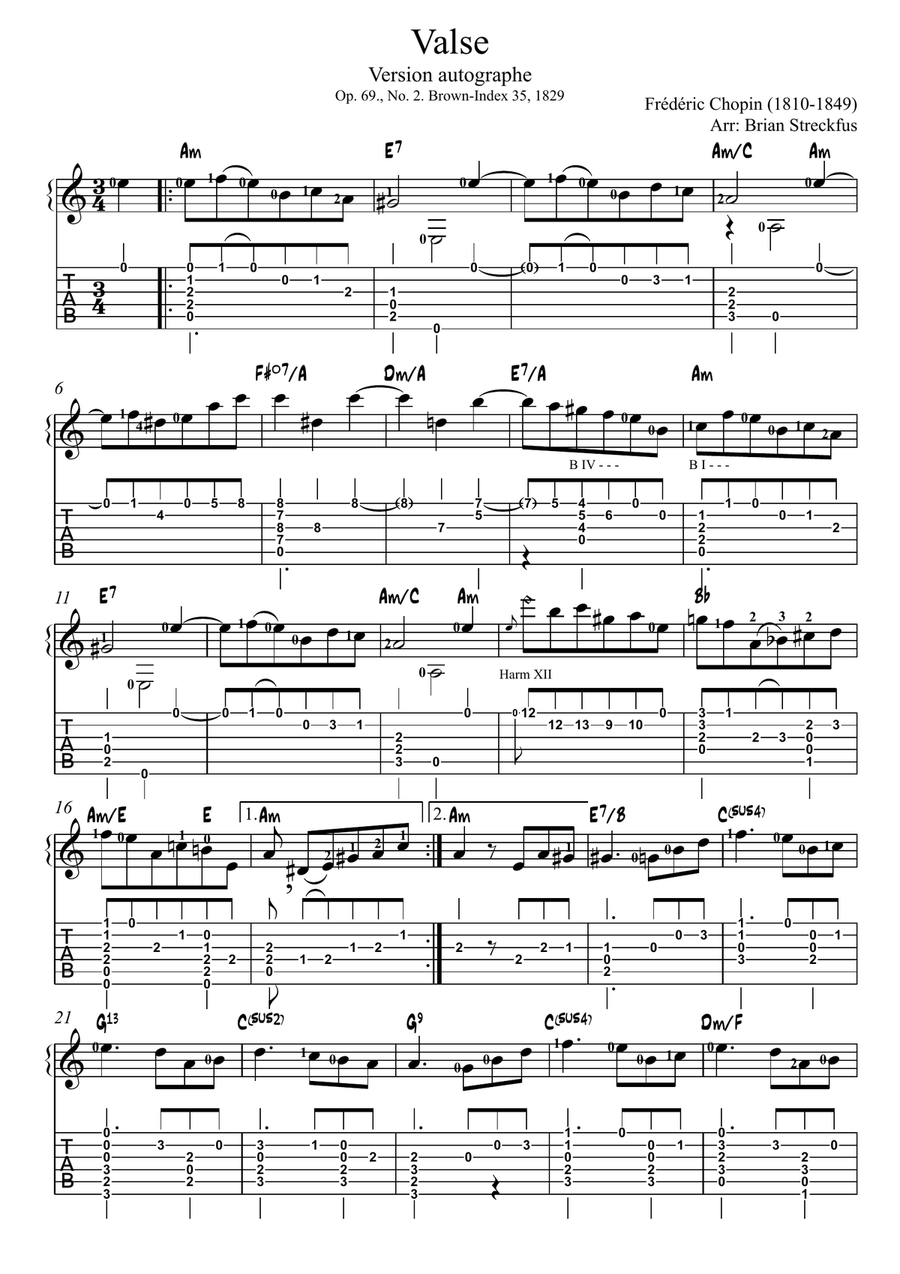Guitar - Level 3 - Digital Download SKU: A0.1177383 By Frederic Chopin. By FreÌdeÌric Chopin. Arranged by Brian Streckfus. 19th Century,Classical,Contemporary,Instructional,Romantic Period. Guitar Tab. 6 pages. Brian Streckfus #776814. Published by Brian Streckfus (A0.1177383). Key: Changed from B minor to A minorCapo: 2 (If you want original key, but I wasn't a fan of capo 2; it felt like there was no bass notes.)1. Arranged for guitar. 2. Piano pedal markings removed 3. Phrase markings removed and opted for commas. 4. Re-harmonized 5. Key changed from B minor to A minor. 6. Slurs 7. Left hand fingers 8. Tablature9. Harmonics added when advantageous, but playing the regular note would work as well.10. Piano pedal markings removed and replaced with commas. It's a flaw of sheet music that slurs, ties, and phrase markings are all the same symbol, and having all three happening can clutter a score.Compromises This may sound obvious, but of course I had to make some alterations to make this flow properly on guitar. Many of the original chord inversions on the piano were not kept. However, many harmonies were kept intact as far as following the chord nomenclature name. Measure 50 was originally an A minor chord, the irony is that the F major suprise is an homage to Chopin anyways, suprised he didn't opt for it. To be honest, I don't like how there is a perfect authentic cadence in measure 50. I think modern audiences would want to clap too badly, so I believe that ending needs to be slightly messed up to propel the music forward, and give a sense that there is still a problem. The other chord that was changed was an E7b9 to a Ddim7 in measure 78. If you know your theory well, you'll realize these chords have the same exact function and nearly the same notes, it's just that Ddim7 flowed a bit better on guitar. I'd rather have guitarists play the rhythms correctly and with musicality, than have guitarist clunkily go though overly large chords in order to mantain historical accuracy. Measure 15 was hard to keep the original chord intact. A Bb/D with a G in the melody as a suspension sounds more like a g minor chord. That is cliche Chopinesque neopolitan moment so the Bb is crucial to mantain. Having some rough sort of Bbmaj7 or G minor chord while mantaining the melody seemed to sound the best even though the name of the chord might have gotten a little off. I tried chord charts, but they seemed messier than what it was worth. I also could have the denser tablature in the sheet music, but that does make it look 10x more intimidating. So this version is unique in that the tablature is my denser arrangement, whereas the sheet music would allow someone to quickly make a new arrangement. I like this ethos because most guitarists are likely to be much better at playing chord quickly when they don't have to have an exact voicing. This makes this arrangement easier to further perfect since I am naming the harmonies, which often isn't done in classical music.BackstoryThis is one of my favorite pieces, and also my favorite composer. I feel classical guitar repertoire is lacking easily playable music in the romantic style. Often, if it is romantic guitar music, it is extemely difficult and therefore only a select few can enjoy performing it. Also, I sometimes get my hopes up to find a romantic guitar composer, but then after listening, there's nothing quite like Chopin. Obviously, you will have to have some chops to play this since it's one of the most ambitious undertakings a guitarist could take, but it's also not so hard that you have to be train for a decade because I changed the key.
